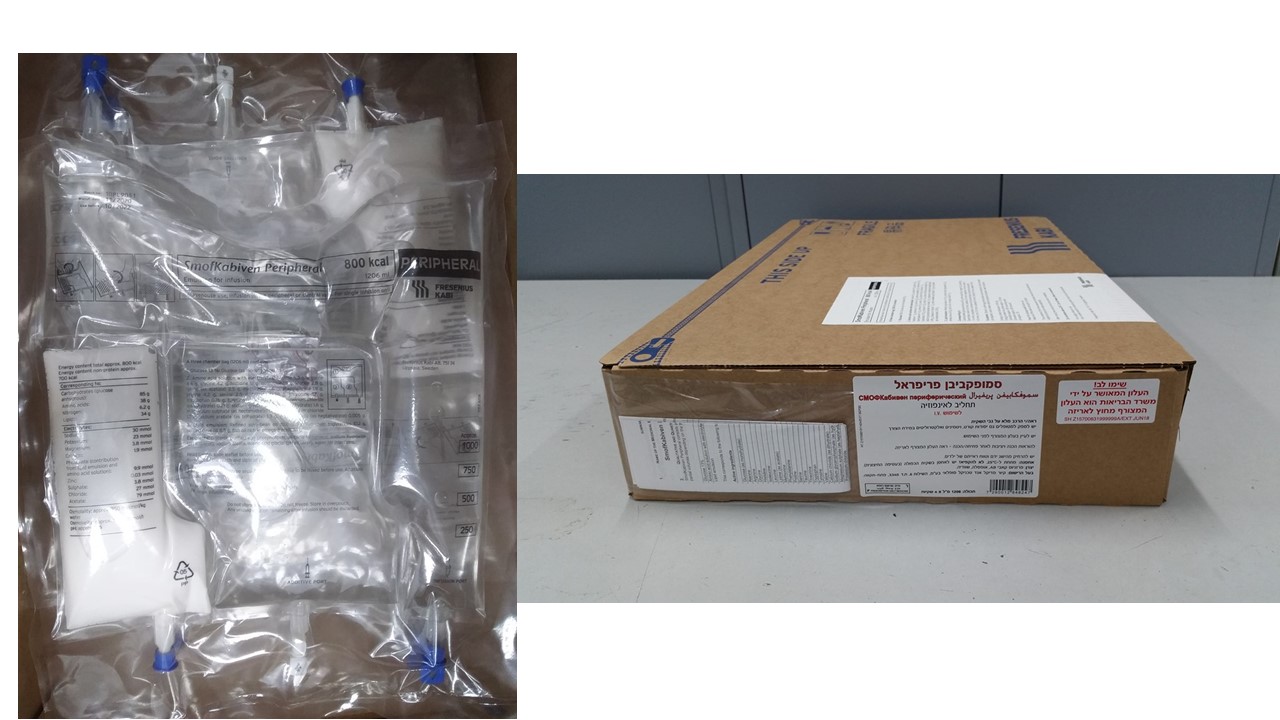Quest for the right Drug

סמופקביבן פריפראל SMOFKABIVEN PERIPHERAL (AMINOACETIC ACID, CALCIUM CHLORIDE DIHYDRATE, FISH OIL, GLUCOSE MONOHYDRATE, L- ALANINE, L- ISOLEUCINE, L- LEUCINE, L- LYSINE ACETATE, L- METHIONINE, L- PHENYLALANINE, L- PROLINE, L- SERINE, L- THREONINE, L- TRYPTOPHAN, L- TYROSINE, L- VALINE, L-ARGININE, L-HISTIDINE, MAGNESIUM SULFATE HEPTAHYDRATE, OLIVE OIL, POTASSIUM CHLORIDE, SODIUM ACETATE TRIHYDRATE, SODIUM GLYCEROPHOSPHATE HYDRATE, SOYA OIL, TAURINE, TRIGLYCERIDES, MEDIUM-CHAIN, ZINC SULFATE HEPTAHYDRATE)
צורת מתן:
תוך-ורידי : I.V
צורת מינון:
תחליב לאינפוזיה : EMULSION FOR INFUSION
עלון לרופא
מינוניםPosology התוויות
Indications תופעות לוואי
Adverse reactions התוויות נגד
Contraindications אינטראקציות
Interactions מינון יתר
Overdose הריון/הנקה
Pregnancy & Lactation אוכלוסיות מיוחדות
Special populations תכונות פרמקולוגיות
Pharmacological properties מידע רוקחי
Pharmaceutical particulars אזהרת שימוש
Special Warning עלון לרופא
Physicians Leaflet
Posology : מינונים
4.2 Posology and method of administration Posology The appearance of the product after mixing the 3 chambers is a white emulsion. The patient’s ability to eliminate lipids and metabolise nitrogen and glucose, and the nutritional requirements should govern the dosage and infusion rate, see section 4.4. The dose should be individualised to the patient’s clinical condition, body weight (bw), nutritional and energy requirements, adjusting dosage based upon additional oral/enteral intake. The nitrogen requirements for maintenance of body protein mass depend on the patient’s condition (e.g. nutritional state and degree of catabolic stress or anabolism). Adults The requirements are 0.6-0.9 g amino acids/kg bw/day (0.10-0.15 g nitrogen/kg bw/day) in the normal nutritional state or in conditions with mild catabolic stress. In patients with moderate to high metabolic stress with or without malnutrition, the requirements are in the range of 0.9-1.6 g amino acids/kg bw/day (0.15-0.25 g nitrogen/kg bw/day). In some very special conditions (e.g. burns or marked anabolism) the nitrogen need may be even higher. Dosage: The dosage range of 20 ml-40 ml SmofKabiven Peripheral/kg bw/day will provide 0.6-1.3 g amino acids/kg bw/day (corresponds to 0.10-0.20 g nitrogen/kg bw/day) and 14-28 kcal/kg bw/day of total energy (11-22 kcal/kg bw/day of non-protein energy). This covers the need of the majority of the patients. In obese patients the dose should be based on the estimated ideal weight. Infusion rate: In general, themaximum infusion rate for glucose is 0.25 g/kg bw/h, for amino acids 0.1 g/kg bw/h, and for lipids 0.15 g/kg bw/h. The infusion rate of this product should not exceed 3.0 ml/kg bw/h (corresponding to 0.10 g amino acids, 0.21 g glucose and 0.08 g lipids/kg bw/h). The recommended infusion period is 14-24 hours. Maximum daily dose: The maximum daily dose varies with the clinical condition of the patient and may even change from day to day. The recommended maximum daily dose is 40 ml/kg bw/day. The recommended maximum daily dose of 40 ml/kg bw/day will provide 1.3 g amino acids/kg bw/day (corresponding to 0.2 g nitrogen/kg bw/day), 2.8 g glucose/kg bw/day, 1.1 g lipids/kg bw/day and a total energy content of 28 kcal/kg bw/day (corresponding to 22 kcal/kg bw/day of non-protein energy). Paediatric population Children (2-11 years) Dosage: The dose up to 40 ml/kg bw/day should be regularly adjusted to the requirements of the paediatric patient that varies more than in adult patients. Infusion rate should be determined according to the physician's decision, taking into account the maximum daily dose of the solution that can be administered to children (40 ml/kg bw/day). The recommended maximum infusion rate is 3.0 ml/kg bw/h (corresponding to 0.10 g amino acids/kg/h, 0.21 g/glucose/kg/h and 0.08 g lipids/kg/h). At the recommended maximum infusion rate, do not use an infusion period longer than 13 hours 20 minutes (corresponding to the maximal daily dose of 40 ml/kg bw/day), except in exceptional cases and with careful monitoring. The recommended infusion period is 12-24 hours. The duration of treatment should not exceed 30 days. If using the recommended maximum daily dose, the dose should be infused during a period of at least 13 hours to not exceed the recommended maximum infusion rate, except in particular cases. Maximum daily dose: The maximum daily dose varies with the clinical condition of the patient and may even change from day to day. The recommended maximum daily dose is 40 ml/kg bw/day. This recommended maximum daily dose of 40 ml/kg bw/day will provide 1.3 g amino acids/kg bw/day (corresponding to 0.2 g nitrogen/kg bw/day), 2.8 g glucose/kg bw/day, 1.1 g lipids/kg bw/day and a total energy content of 28 kcal/kg bw/day (corresponding to 22 kcal/kg bw/day of non-protein energy). Adolescents (12-16/18 years) In adolescents, SmofKabiven Peripheral can be used as in adults. Method of administration Intravenous use, infusion into a peripheral or central vein. SmofKabiven Peripheral is available in three pack sizes intended for patients with moderately increased or basal nutritional requirements. To provide total parenteral nutrition, trace elements, vitamins and possibly electrolytes (taking into account the electrolytes already present in SmofKabiven Peripheral) should be added to SmofKabiven Peripheral according to the patients need. For instructions on preparation of the medicinal product before administration, see section 6.6.

ATC
מידע נוסף
עלון מידע לרופא
03.12.20 - עלון לרופאעלון מידע לצרכן
03.12.20 - החמרה לעלוןלתרופה במאגר משרד הבריאות
סמופקביבן פריפראל